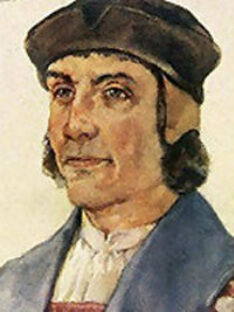The concepts covered in this sheet go beyond those seen in secondary school. It is intended as a supplement for those who are curious to find out more.
The Portuguese and Spanish were the first to embark on major expeditions. The French and British kingdoms soon followed. These expeditions led to the discovery of new regions of the African continent, the American continent, the Pacific Ocean and several passageways. All these expeditions eventually led to the colonization and exploitation of the new territories.
Among the great explorers were Bartolomeu Dias, Christopher Columbus, Vasco de Gama, Jean Cabot, Fernand de Magellan and Jacques Cartier.
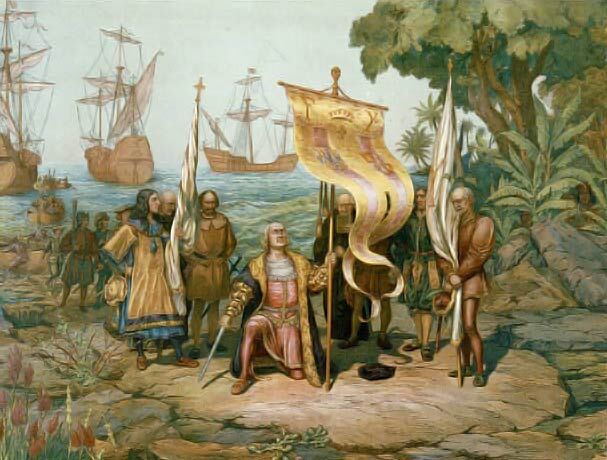
Arrival of Christopher Columbus in America in October 1492
This explorer is best known for crossing the southern tip of Africa in 1487 (now known as the Cape of Good Hope).
Bartolomeu Dias was a precursor to Vasco da Gama's expeditions. In 1487, he set off on an expedition to the Congo. Caught in unfavourable winds, he headed south. After a heavy storm, he managed to round the southern tip of Africa. The cape he had just rounded is now known as the Cape of Good Hope. He did not venture much further east of this point. His crew urged him to turn back.
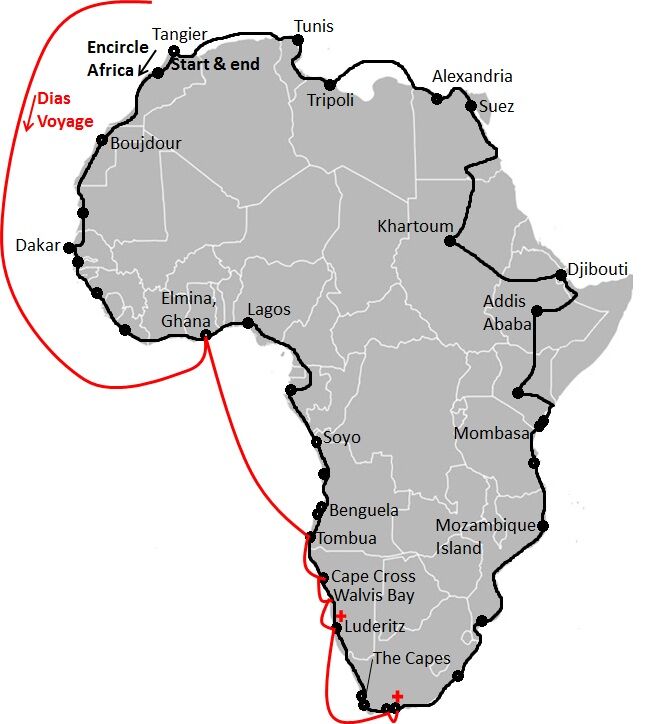
Voyage de Bartolomeu Dias in 1487
He returned to Portugal in December 1488. He had not reached the Indies, but he announced that he had found the way. Christopher Columbus is even said to have witnessed this return, and to have realised that his plan to find the route via the west would now be harder to sell to his sponsors.
He is famous for having reached America in 1492, marking the beginning of the exploration of this continent. He achieved this achievement with Spanish funding, which enabled him to make several voyages.
Relying on the maps of the time, Christopher Columbus (1451-1506) was convinced that it was entirely possible to reach the Indies from the west by crossing a single ocean. He also believed, based on his knowledge and observations of astronomy and cartography, that the earth really was round. So he set about crossing the ocean. According to him, the ocean to be crossed was not that wide. He finally managed to find sponsors to finance his voyage.
The project was initially rejected by the Portuguese, who were now concentrating on the Cape of Good Hope route. However, the Spanish agreed to it if he added a religious aspect to his voyage. Columbus accepted to satisfy the Catholic royalty.
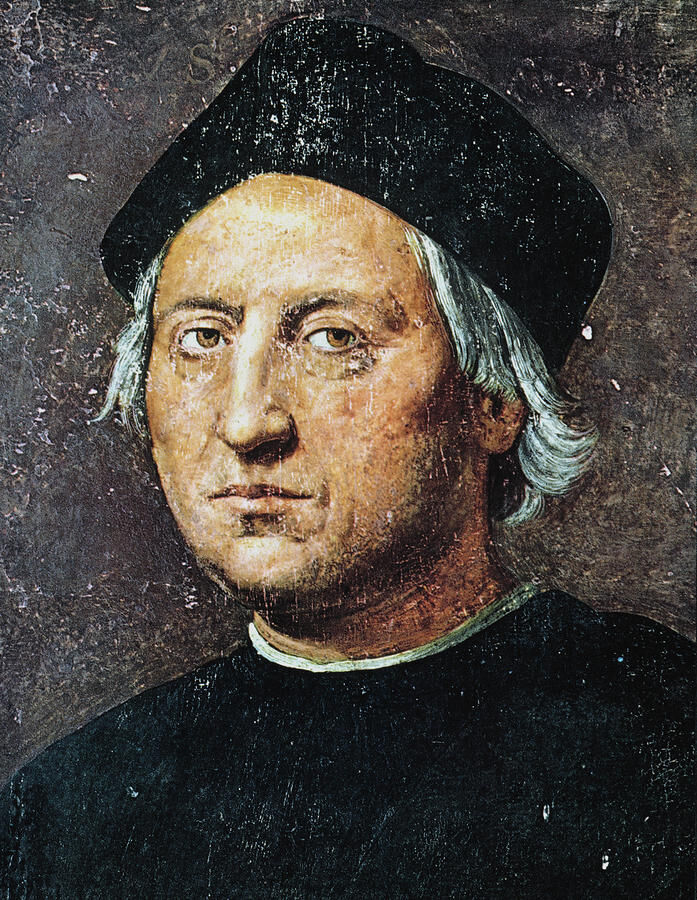
Christophe Colomb
On August 3 1492, three caravel ships set sail for the west. During the crossing, the crew lost patience: the ocean was much longer than expected. Columbus and his crew finally landed on a shore in the Bahamas. Convinced that he had reached India, Columbus made contact with the natives. Finding no riches, he continued on his way, reaching Cuba and Haiti in succession, where he established a garrison. After staying there for some time, he returned to Spain, where he received a triumphant welcome despite the lack of riches.
Columbus undertook a second trip in 1493. This time he left with 17 ships. However, this new voyage did not go as well as planned: his garrison was ravaged by disease and relations with the natives deteriorated. Columbus also discovered the cannibalism of the natives. For this reason, he forced them into slavery and set about evangelizing them. He returned to Seville again in 1496, without any riches.
Christopher Columbus left again in 1498. When he arrived, he still couldn't believe that there was another continent between Europe and Asia, so he thought he had discovered a new region of the Indies. Once again, his voyage did not go smoothly: his garrisons fought and Columbus set up a system for distributing the natives. He even organised a slave trade to Spain. The death rate among the natives climbed as a result of disease, forced labour, lack of food, suicide and this new life far from tribe and family. An investigator sends Columbus back to Spain to justify his lack of wealth and his treatment of the natives.
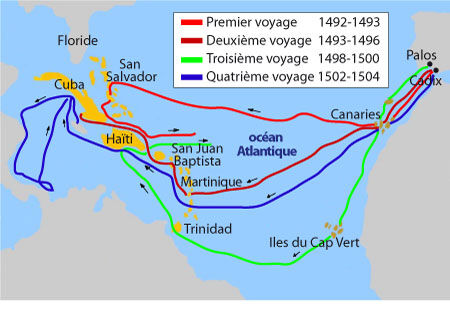
The 4 voyages of Christopher Columbus
Christopher Columbus embarks on a final expedition to explore the coast of Honduras. There was still no gold, and he was still convinced that this was not a new continent.
This courageous adventurer is famous for having found a route to India by bypassing Africa. He achieved this in 1497 despite the many obstacles he encountered on his travels.
Vasco da Gama (1469-1524) was the navigator who was to take over Bartolomeu Dias's mission. The expeditions were difficult: long periods at sea, unknown geography, scurvy, mutinies. For this reason, the mission was entrusted to a military man who could unite the troops and avoid too hasty a return.
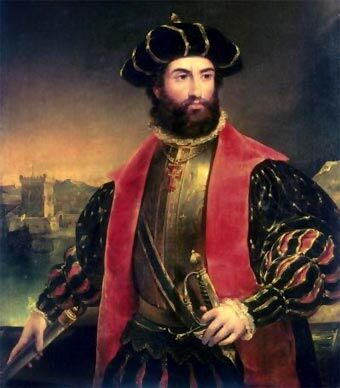
Vasco de Gama
His mission was to forge alliances with the rulers of the Indies in order to trade more cheaply. Dias organised the preparations. Four ships left on July 8 1497. The crew consisted of around 170 men, including men condemned to death (who could be useful on dangerous missions) and translators.
Vasco da Gama followed Dias's instructions and sailed away from the coast. However, many of the crew were suffering from a lack of vitamins and too much salt water. The ships therefore sailed closer to the coast to refuel. The fleet finally rounded the Cape of Good Hope. However, the voyage was punctuated by a number of setbacks: scurvy, storms, lack of water, loss of a ship and conflicts. They still reached the Indian coast in May 1498. As Vasco da Gama was an army man, he had not taken enough wealth with him to create the desired trade links, so he could not leave with his holds full of spices and other riches.
On his return to Portugal with 44 men, the king was nonetheless satisfied, since an initial contact had been established. He set up a new expedition, which proved successful: the crew returned with a large quantity of spices. Vasco da Gama returned to India to wage war against the Muslims and demonstrate Portugal's true strength. Unfortunately, he died in India. However, his travels enabled his country to build an empire in India.
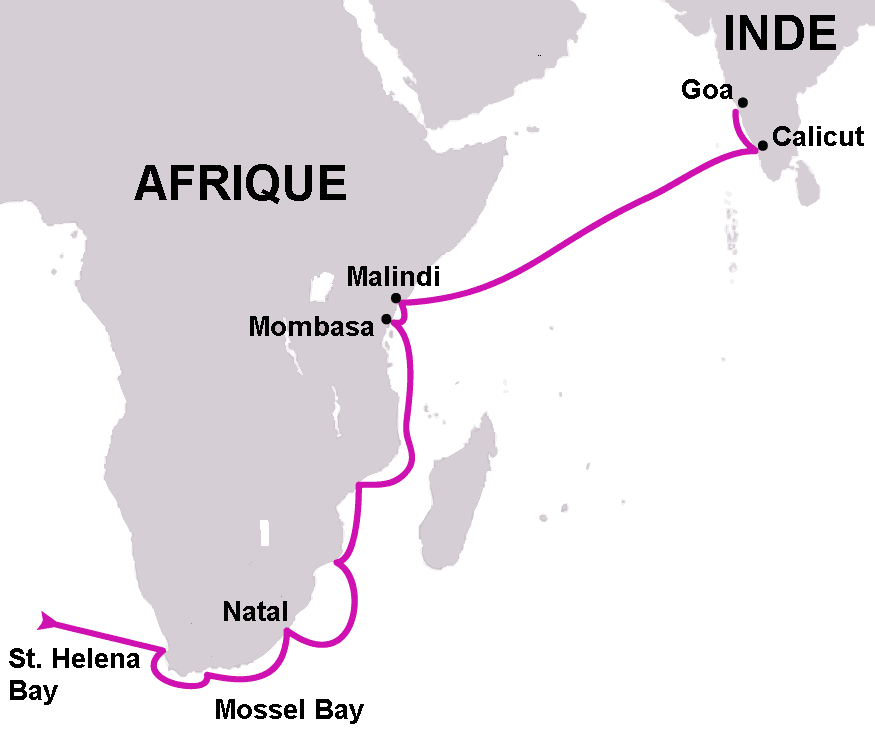
The route taken by Vasco De Gama
Giovanni Caboto is better known as Jean Cabot or John Cabot. Of Italian origin, he worked as a merchant. This work took him on several trips to the Middle East. Cabot wanted to reach the riches of India on his own via the west. So he asked the King of England for help in undertaking a trip to find a route to Asia, but also to find new lands.
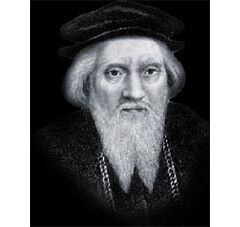
Giovanni Caboto
He undertook his first expedition in 1496. It was a failure, and the expedition was brought to an end by bad weather and a lack of food and water.
He made his second expedition in 1497. This one was much more successful. Following a more northerly route, he reached a shore. It may have been Labrador, Newfoundland, Cape Breton Island or Prince Edward Island. Cabot immediately noticed schools of cod. Believing he had reached Asia, he announced to the King on his return to England that he had reached the Asian continent and that there was an abundance of cod.
Cabot set off on a third expedition in 1498 to continue his explorations. Unfortunately, there is no record of this voyage. There is some speculation that Cabot and his ship ran aground during this journey. However, there are no documents to support this hypothesis. This is the last known record of Cabot's trip.
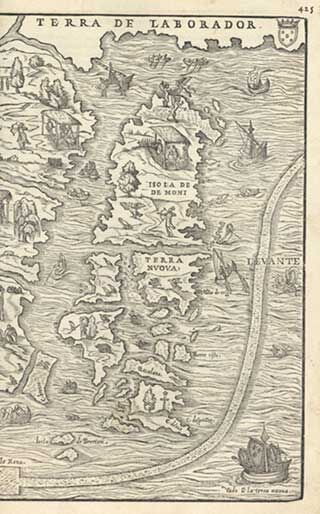
Mapping the travels of Jean Cabot
It was Cabot's exploration in 1497 that sparked England's interest in America and its various possibilities.
This Portuguese explorer was the first to achieve the extraordinary exploit of sailing around the world. He achieved this in 1522. Spain agreed to finance his travels.
Ferdinand de Magellan (1480-1521) was a Portuguese sailor who spent a long time working in India. On his return to Portugal, he heard about the various expeditions that had taken place to the west. He wanted to undertake a similar voyage. After being refused by the King of Portugal, he convinced the King of Spain to let him undertake a huge voyage.
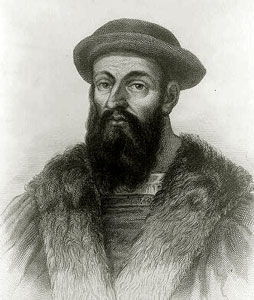
Ferdinand de Magellan
On August 15, 1519, Magellan and his crew set sail from Spain. After crossing the Atlantic, the fleet stayed in Brazil for 13 days. Magellan then decided to spend the winter in Patagonia. His aim was to go south to find a passage. He succeeded in finding a passage through the strait that now bears his name. However, he lost two of his ships: one ran aground and the other returned to Spain. Magellan continued on his way, first heading north and then west.
It was while sailing on the calm, flat ocean that Magellan gave it its name: the Pacific Ocean. Continuing his journey, he reached the Philippines, where he died trying to protect his soldiers. Two ships continued on their way to the spices. One of them, however, set course for the east. The two ships had several run-ins with the Portuguese. However, one of the ships returned to Seville in September 1522: the first circumnavigation of the globe had just been completed.
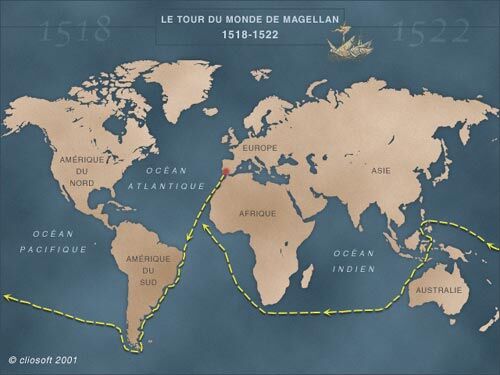
Magellan's world tour
Of all the men in the original crew, only one eighth returned to Seville. The others suffered from hunger and disease, were taken prisoner or died in battle. The sale of the spices brought back by the ship was enough to cover all the costs of the expedition. The expedition led to the discovery of the Strait of Magellan, the Mariana Islands and the Philippines, and enabled Spain to build an empire controlling the Pacific Ocean.
This navigator was hired by the King of France in 1534 to discover a route to India. He landed in Gaspé, among other places, and had many contacts with the natives.
Born into a family of sailors, Jacques Cartier (1491-1557) was hired by the King of France to discover the route to India by sailing northwest.
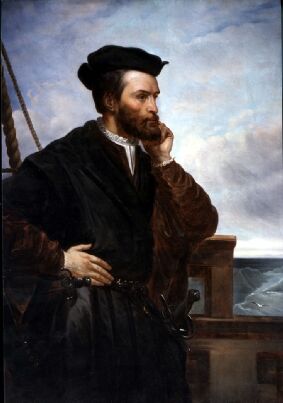
Jacques Cartier
His first voyage began in 1534, when cod fishing was already taking place in the Labrador sector. He crossed the ocean in just 20 days. He skirted the coasts of Newfoundland, Labrador, the Magdalen Islands and Prince Edward Island. Looking for a passage westwards, he explored several bays: Baie des Chaleurs, Baie de Gaspé, etc. He stayed there for a short time and made his first contacts with the Aboriginals. He returned to France in September 1534.
He left for a second voyage in May 1535. He resumed his explorations of the Côte-Nord region, naming a bay the Saint-Laurent, a name that was later used for the gulf and the river. Aboriginal people gave him information about this river: an immense stream that narrows, where the water becomes fresh and whose source no one had ever seen. Cartier was convinced that he had the famous passage he was looking for.
He set off upstream, past the Saguenay and finally arrived at Hochelaga (Montreal), before returning to France. The results of the second voyage were positive: the route to the continent had been found, good contact had been established with the Aboriginals and they might know where to find gold.
A new expedition began, in which Jacques Cartier became Jean-François de La Rocque de Roberval's subordinate. However, Cartier left France long before his superior. As soon as he arrived in the new lands, the situation became more difficult: relations with the Aboriginals became more complicated and a number of diseases claimed the lives of the colonists. Cartier left before Roberval arrived. He returned to France, convinced that his holds were full of diamonds and gold. When he arrived in France, he realised that the materials looked like them, but were worthless.
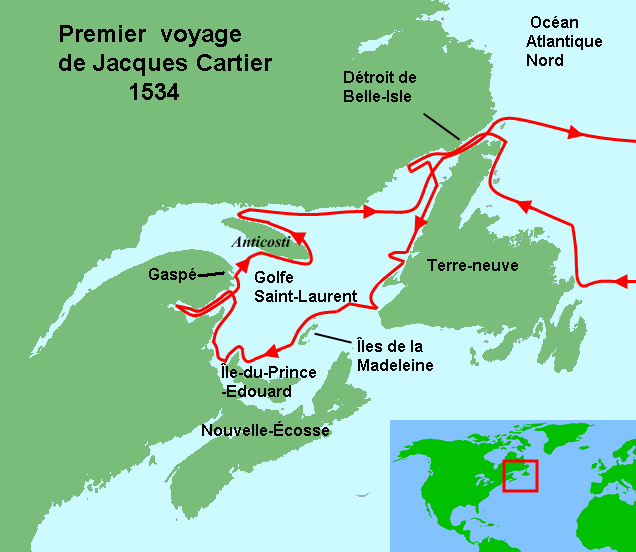
Jacques Cartier's first voyage
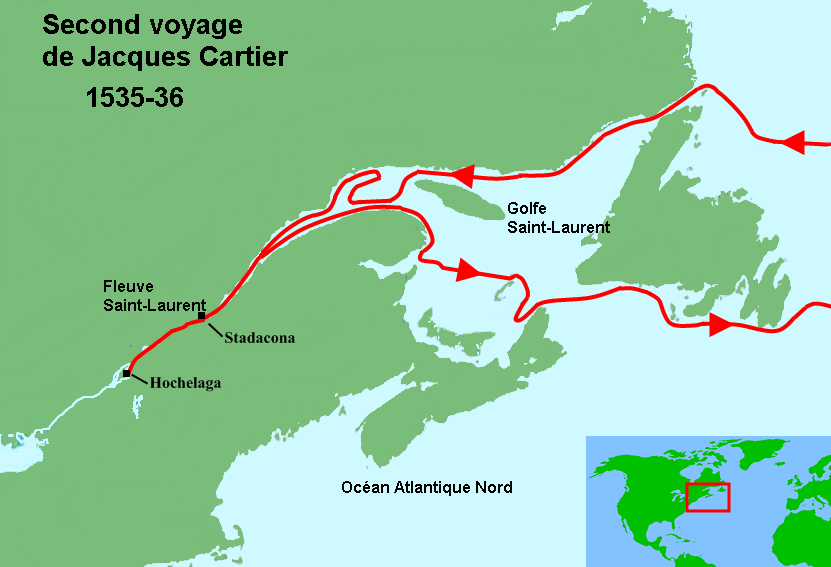
Jacques Cartier's second voyage
Cartier ‘s travel writings also provide an insight into his first impressions of the landscape and the Aboriginal peoples.
